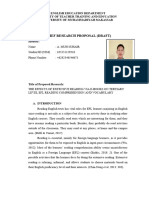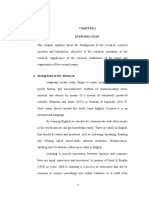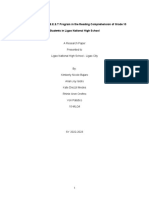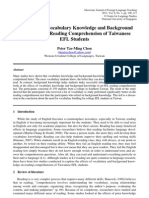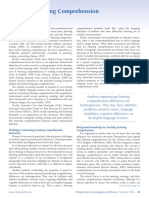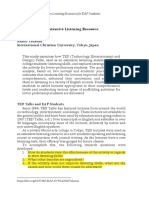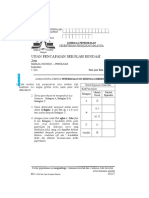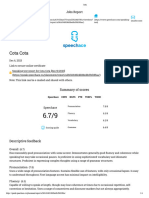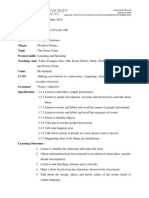0 ratings0% found this document useful (0 votes)
56 viewsPqe 7010 Literacy Development
Pqe 7010 Literacy Development
Uploaded by
viniThis research proposal aims to investigate reading fluency and vocabulary difficulties among adolescents struggling with reading comprehension. The objectives are to identify issues with reading fluency and vocabulary, and ways to improve these skills to enhance reading comprehension. The research questions ask why adolescents have difficulties with fluency and vocabulary, and how to improve these areas. A literature review discusses reading skills like fluency and comprehension, vocabulary instruction and knowledge, and a model of adolescent reading. The methodology and future milestones are also mentioned.
Copyright:
© All Rights Reserved
Available Formats
Download as PPTX, PDF, TXT or read online from Scribd
Pqe 7010 Literacy Development
Pqe 7010 Literacy Development
Uploaded by
vini0 ratings0% found this document useful (0 votes)
56 views17 pagesThis research proposal aims to investigate reading fluency and vocabulary difficulties among adolescents struggling with reading comprehension. The objectives are to identify issues with reading fluency and vocabulary, and ways to improve these skills to enhance reading comprehension. The research questions ask why adolescents have difficulties with fluency and vocabulary, and how to improve these areas. A literature review discusses reading skills like fluency and comprehension, vocabulary instruction and knowledge, and a model of adolescent reading. The methodology and future milestones are also mentioned.
Original Description:
Pqe
Original Title
PQE 7010 LITERACY DEVELOPMENT
Copyright
© © All Rights Reserved
Available Formats
PPTX, PDF, TXT or read online from Scribd
Share this document
Did you find this document useful?
Is this content inappropriate?
This research proposal aims to investigate reading fluency and vocabulary difficulties among adolescents struggling with reading comprehension. The objectives are to identify issues with reading fluency and vocabulary, and ways to improve these skills to enhance reading comprehension. The research questions ask why adolescents have difficulties with fluency and vocabulary, and how to improve these areas. A literature review discusses reading skills like fluency and comprehension, vocabulary instruction and knowledge, and a model of adolescent reading. The methodology and future milestones are also mentioned.
Copyright:
© All Rights Reserved
Available Formats
Download as PPTX, PDF, TXT or read online from Scribd
Download as pptx, pdf, or txt
0 ratings0% found this document useful (0 votes)
56 views17 pagesPqe 7010 Literacy Development
Pqe 7010 Literacy Development
Uploaded by
viniThis research proposal aims to investigate reading fluency and vocabulary difficulties among adolescents struggling with reading comprehension. The objectives are to identify issues with reading fluency and vocabulary, and ways to improve these skills to enhance reading comprehension. The research questions ask why adolescents have difficulties with fluency and vocabulary, and how to improve these areas. A literature review discusses reading skills like fluency and comprehension, vocabulary instruction and knowledge, and a model of adolescent reading. The methodology and future milestones are also mentioned.
Copyright:
© All Rights Reserved
Available Formats
Download as PPTX, PDF, TXT or read online from Scribd
Download as pptx, pdf, or txt
You are on page 1of 17
PQE 7010 LITERACY
DEVELOPMENT
LECTURER’S NAME :DR HUZAINA BT ABD HALIM
STUDENT’S NAME :SYAHIRAH MOHD SOFIAN (PQE180019)
RESEARCH PROPOSAL
Investigating Reading Fluency and
Vocabulary Difficulties Among Adolescents
Struggling With Reading Comprehension
PART I
Research background
Research objectives
The objectives of this research are:
a) To investigate reading fluency and vocabulary difficulties among
adolescents
b) To address problems in reading fluency and vocabulary difficulties
among adolescents
Research question(s)
a) Why adolescents with reading fluency and vocabulary difficulties
are struggling with reading comprehension?
b) How to enhance reading fluency and vocabulary difficulties in
reading among adolescents?
PART II
Literature review
1) Reading skills
a) reading fluency
Given what we know about the relationship between fluency and verbal understanding
of reading and the classification of threshold values it is reasonable to assume that
fluency skills may be inadequate for adolescents to fully support comprehension
processing.
(Paris & Hamilton, 2009)
Reading at a reasonable pace has a very practical purpose. Reading activity inside and
outside the school help avoid reader disappointment. With a lethargic and exhausting
reading speed that can make reading easier.
(Rasinski, 2000)
b) reading comprehension
As understanding involves the interaction of various cognitive abilities and
processes, in many cases difficulties arise and lead to misunderstandings. For
example, during reading the ability to derive meaning is normally enhanced
when there is a reduction in the cognitive load of a reader’s working memory,
and the reader can decode the words and phrases fluently and bring meaning
to the unfamiliar vocabulary encountered
(Cain & Oakhill 2007)
Reading comprehension (understanding, obtaining meaning and interpretation of
the text) depends on various factors that affect the reader, the text and the situation.
(De Corte et al. 2001)
c) adolescents reading theoretical model
The Adolescents Reading Model shown in the figure provides a conceptual
framework that defines the design and implementation of reading measures.
2) Vocabulary
a) vocabulary instruction
The vocabulary is one of the five main components of the reading instruction, which is
necessary for the successful reading of children. These basic components include
phonetics and words, fluency, vocabulary and comprehension. Vocabulary knowledge
is important because it encompasses all the words we must know to access our
background knowledge, express our ideas and communicate effectively, and learn
about new concepts. “
(National Reading Panel, 2000)
b) vocabulary knowledge
The growth of children's vocabulary should be based on the recognition of the
complexity of word knowledge. They indicated five vocabulary characteristics.
(Nadia & Scott 2000)
PART III
Methodology
PART IV
Milestone
Allocation of budgets
References
De Corte, E., Verschaffel, L., & Van De Ven, A. (2001). Improving text comprehension
strategies in upper primary school children: A design experiment. British Journal of
Educational Psychology, 71(4), 531-559.
National Reading Panel (2000). Teaching children to read: An evidence-based assessment
of scientific research literature on reading and its implications for reading instruction.
Bethesda, MD: National Institutes of Health.
Oakhill, J., & Cain, K. (2007). Issues of causality in children’s reading
comprehension. Reading comprehension strategies: Theories, interventions, and
technologies, 47-71.
Rasinski, T. V. (2000). Commentary: Speed does matter in reading. The Reading
Teacher, 54(2), 146-151.
You might also like
- William Grabe ReadingDocument11 pagesWilliam Grabe Readingmasthozheng100% (2)
- Mother Tongue AssessmentDocument58 pagesMother Tongue AssessmentMar SebastianNo ratings yet
- Thesis Chapter 1Document21 pagesThesis Chapter 1Bea DeLuis de TomasNo ratings yet
- GROUP7Document13 pagesGROUP7Jeofrey Melchor LanciolaNo ratings yet
- Tools and Teaching Strategies For Vocabulary AssesDocument33 pagesTools and Teaching Strategies For Vocabulary AssesWarth DianaNo ratings yet
- Factors Affecting The Reading Comprehension of Grade 7 in Kalinga Colleges Science and Technolog1Document10 pagesFactors Affecting The Reading Comprehension of Grade 7 in Kalinga Colleges Science and Technolog1Gallardo, Lourdes B.No ratings yet
- English Research WordDocument26 pagesEnglish Research Wordeugene colloNo ratings yet
- Investigating English Reading Comprehension Problems of Cambodian High School StudentsDocument5 pagesInvestigating English Reading Comprehension Problems of Cambodian High School StudentsLong VichekaNo ratings yet
- Assessment of Reading Comprehension SkilDocument36 pagesAssessment of Reading Comprehension SkilJem Mimi SerańapNo ratings yet
- Reading Comprehension RRLDocument4 pagesReading Comprehension RRLRochel BatalladorNo ratings yet
- KupsDocument21 pagesKupsSir G-ChNo ratings yet
- Research ReportDocument18 pagesResearch Reportwenna janeNo ratings yet
- Revised eDocument23 pagesRevised esidrence bajentingNo ratings yet
- Effect of Gate Pass of Bongabon Essential School Students English ComprehensionDocument9 pagesEffect of Gate Pass of Bongabon Essential School Students English ComprehensionAngel Padilla CatacutanNo ratings yet
- Reading Comprehension Research Paper2Document22 pagesReading Comprehension Research Paper2dewiNo ratings yet
- Action Research - Think HighFINALDocument28 pagesAction Research - Think HighFINALFelipe Lucena JrNo ratings yet
- Thesis About Factors Affecting Reading ComprehensionDocument7 pagesThesis About Factors Affecting Reading Comprehensiondebbirchrochester100% (2)
- An Action Research ReportDocument28 pagesAn Action Research ReportMaryGraceBacalsoNo ratings yet
- A Review of The Current Research On Vocabulary InstructionDocument26 pagesA Review of The Current Research On Vocabulary InstructionSyarifuddin RMNo ratings yet
- Proposal DraftDocument17 pagesProposal DraftgoesNo ratings yet
- Using "Go Rosemary Go" To Enhance The Year 4 Pupil'S in Answering Reading Comprehension QuestionsDocument10 pagesUsing "Go Rosemary Go" To Enhance The Year 4 Pupil'S in Answering Reading Comprehension QuestionsNoradila NasirrudinNo ratings yet
- 3077-Article Text-12226-1-10-20211012Document12 pages3077-Article Text-12226-1-10-20211012Aulia RahmiNo ratings yet
- Thesis 4 2Document58 pagesThesis 4 2Happy AyalaNo ratings yet
- Bab 1 Dan 2 3 4 5.OKDocument38 pagesBab 1 Dan 2 3 4 5.OKYuni RestiaNo ratings yet
- Skripsi FixDocument58 pagesSkripsi Fixresky awaliaNo ratings yet
- The Level of Students Experiencing Difficulties in Reading and Understanding Among Senior High SchoolDocument20 pagesThe Level of Students Experiencing Difficulties in Reading and Understanding Among Senior High SchoolKim D. GottschalkNo ratings yet
- NiceDocument24 pagesNicegerbbyaragon125No ratings yet
- Chapter-1 5Document17 pagesChapter-1 5エスゲラ ミエル エンゼルNo ratings yet
- The ProblemDocument26 pagesThe ProblemNizelle Amaranto ArevaloNo ratings yet
- DevRead Assignment Summary of ReadingsDocument10 pagesDevRead Assignment Summary of ReadingsLeriMarianoNo ratings yet
- Improving English Reading Comprehension Ability Through Survey, Questions, Read, Record, Recite, Review Strategy (SQ4R)Document10 pagesImproving English Reading Comprehension Ability Through Survey, Questions, Read, Record, Recite, Review Strategy (SQ4R)Jay Mark Calderon SalvadorNo ratings yet
- 2021Examiningthecontributionofcognitiveflexibilitytometalinguisticskillsandreadingcomprehension - 副本Document19 pages2021Examiningthecontributionofcognitiveflexibilitytometalinguisticskillsandreadingcomprehension - 副本272883813No ratings yet
- The Effectiveness of B.E.S.T Program in The Reading Comprehension of Grade 10 Students in Ligao National High SchoolDocument12 pagesThe Effectiveness of B.E.S.T Program in The Reading Comprehension of Grade 10 Students in Ligao National High SchoolKateDrezzil MedesNo ratings yet
- Chapter 1 The Problem and Its Scope Research 1Document22 pagesChapter 1 The Problem and Its Scope Research 1nica eurangoNo ratings yet
- Effective Vocabulary InstructionDocument3 pagesEffective Vocabulary InstructionHael LeighNo ratings yet
- 2022 - Dujardin Et Al - Voc&InstructionDocument34 pages2022 - Dujardin Et Al - Voc&InstructiontrikkkNo ratings yet
- RRLDocument12 pagesRRLCristopher Brent Smith82% (11)
- ReportDocument32 pagesReportDarvius ANtoniNo ratings yet
- ChouDocument8 pagesChouyounghorseNo ratings yet
- Chapter IiDocument13 pagesChapter IiAdai AhmadNo ratings yet
- THE CAUSALITY O-WPS OfficeDocument56 pagesTHE CAUSALITY O-WPS Officenasser aplalNo ratings yet
- Research TempoDocument40 pagesResearch TempoJs LantongNo ratings yet
- Improving Students Reading Comprehension in Narrative Text by Using Story Pyramid Strategy (Article Paper) - 1Document4 pagesImproving Students Reading Comprehension in Narrative Text by Using Story Pyramid Strategy (Article Paper) - 1Roganda SiraitNo ratings yet
- So Tay Tu Vung Hoc Thuat 01-09Document83 pagesSo Tay Tu Vung Hoc Thuat 01-09Dao Anh HienNo ratings yet
- What Is Evidence-Based Reading Instruction and How Do You Know It When You See ItDocument13 pagesWhat Is Evidence-Based Reading Instruction and How Do You Know It When You See ItTaranisaNo ratings yet
- Testing ReadingDocument19 pagesTesting ReadingCharisse Karen RodreguezNo ratings yet
- 5.2 - Reading - 21stcenturyDocument9 pages5.2 - Reading - 21stcenturyruth veraNo ratings yet
- Review of Related Literature and StudiesDocument7 pagesReview of Related Literature and StudiesQueenie Gonzales-Agulo100% (1)
- Factors Affecting Reading ComprehensionDocument4 pagesFactors Affecting Reading ComprehensionJuvy RejusoNo ratings yet
- RES1 - SuliaManlangitPongase - Chapters123 UPDATED April 20Document50 pagesRES1 - SuliaManlangitPongase - Chapters123 UPDATED April 20Regine MalanaNo ratings yet
- Teaching Listening ComprehensionDocument7 pagesTeaching Listening ComprehensionKi-Baek KimNo ratings yet
- TED Talks On Extensive ListeningDocument19 pagesTED Talks On Extensive ListeningThu LeNo ratings yet
- ThesisDocument37 pagesThesisLoid SibayanNo ratings yet
- Chapter IDocument5 pagesChapter IAya Tambuli100% (1)
- Three TopicsDocument10 pagesThree Topicsjanepe47No ratings yet
- Developing Material DesignDocument34 pagesDeveloping Material DesignGirlNo ratings yet
- Reading Comprehension Intervention StrategiesDocument18 pagesReading Comprehension Intervention Strategiesapi-258330934No ratings yet
- 209 210 1 PBDocument14 pages209 210 1 PBKana Saiank DeaaNo ratings yet
- Reading Interventions for the Improvement of the Reading Performances of Bilingual and Bi-Dialectal ChildrenFrom EverandReading Interventions for the Improvement of the Reading Performances of Bilingual and Bi-Dialectal ChildrenNo ratings yet
- Grocery Store Robbery Fill in The Blanks - 100353Document1 pageGrocery Store Robbery Fill in The Blanks - 100353viniNo ratings yet
- Online TuisyenDocument16 pagesOnline TuisyenviniNo ratings yet
- Public Speaking TextDocument2 pagesPublic Speaking Textvini100% (1)
- The Demographic Attributes of Successful Entrepreneurs AreDocument1 pageThe Demographic Attributes of Successful Entrepreneurs AreviniNo ratings yet
- Bi Paper 2 Upsr 2018Document11 pagesBi Paper 2 Upsr 2018viniNo ratings yet
- 1) (Sentence 1)Document2 pages1) (Sentence 1)viniNo ratings yet
- Social Expression: A B A BDocument13 pagesSocial Expression: A B A BviniNo ratings yet
- Semi-Structured Interview QuestionsDocument2 pagesSemi-Structured Interview QuestionsviniNo ratings yet
- Chapter 1: Introduction To The StudyDocument3 pagesChapter 1: Introduction To The StudyviniNo ratings yet
- Pqe 7001 Second Language Acquisition Jigsaw Reading Week 7: Lecturer'S NameDocument4 pagesPqe 7001 Second Language Acquisition Jigsaw Reading Week 7: Lecturer'S NameviniNo ratings yet
- Contoh Format Laporan Laporan Public Speaking SMDocument8 pagesContoh Format Laporan Laporan Public Speaking SMviniNo ratings yet
- Multiliteracies and Multimodality in Language EducationDocument3 pagesMultiliteracies and Multimodality in Language EducationviniNo ratings yet
- Participation - Body Language - Group CooperationDocument2 pagesParticipation - Body Language - Group CooperationviniNo ratings yet
- Literature ReviewDocument3 pagesLiterature ReviewviniNo ratings yet
- 6 Bidang NKRADocument10 pages6 Bidang NKRAviniNo ratings yet
- Assignment: by Sharvni Ap ArumugamDocument15 pagesAssignment: by Sharvni Ap ArumugamviniNo ratings yet
- Candidate Endorsement SheetDocument4 pagesCandidate Endorsement SheetDebbie Jane BuenavistaNo ratings yet
- 2022 Belinda Lesmana 4517101024Document88 pages2022 Belinda Lesmana 4517101024Dewi NurmayasariNo ratings yet
- Paper3 Speaking MayJune2022Document32 pagesPaper3 Speaking MayJune2022K ShenneeNo ratings yet
- Speechace TestDocument4 pagesSpeechace TestConstanza VallejosNo ratings yet
- Academic SpeakingDocument18 pagesAcademic SpeakingVirdha DhewiNo ratings yet
- 14 Methods For Improving Your Spoken English Without A Speaking PartnerDocument8 pages14 Methods For Improving Your Spoken English Without A Speaking PartnerGabi31No ratings yet
- Ell 101Document3 pagesEll 101api-475024951No ratings yet
- 5 Speaking Rules You Need To KnowDocument17 pages5 Speaking Rules You Need To KnowNurfani Fadillah100% (1)
- Module Readability, Reading Skills, and Reading Comprehension of Grade 8 StudentsDocument18 pagesModule Readability, Reading Skills, and Reading Comprehension of Grade 8 StudentsEunice Shiela Mae V. MicarteNo ratings yet
- 4 Clil Art Activities For AnyDocument12 pages4 Clil Art Activities For AnyPepita la florNo ratings yet
- Teaching Alphabet in Grade 1Document12 pagesTeaching Alphabet in Grade 1Diane jane anonuevoNo ratings yet
- Key Mock Test 4Document3 pagesKey Mock Test 4hahaNo ratings yet
- Proven 6 Steps Action Plan To Prepare Your PTE Exam For Getting 79 or 8 Band Each - PTE Real Exam Question Bank PDFDocument5 pagesProven 6 Steps Action Plan To Prepare Your PTE Exam For Getting 79 or 8 Band Each - PTE Real Exam Question Bank PDFHesham RafiNo ratings yet
- Clemens, 2017 PDFDocument17 pagesClemens, 2017 PDFCarmen Espinoza BarrigaNo ratings yet
- Summative Assessment For The Term2 Characteristic of Tasks For Summative Assessment For The 4 TermDocument14 pagesSummative Assessment For The Term2 Characteristic of Tasks For Summative Assessment For The 4 TermaizokoshaNo ratings yet
- The 5 Step Plan For English FluencyDocument24 pagesThe 5 Step Plan For English Fluencyjose100% (1)
- IELTS Marking RubricsDocument1 pageIELTS Marking RubricsHà My TrầnNo ratings yet
- Needs AnalysisDocument12 pagesNeeds Analysisyamid rojas lopezNo ratings yet
- The University of Toronto, Canada: Nina SpadaDocument2 pagesThe University of Toronto, Canada: Nina SpadaNgọc HuyềnNo ratings yet
- Un Virak Soeurn FinalDocument44 pagesUn Virak Soeurn Finalមហា បុរសNo ratings yet
- O Level History Cala BDocument9 pagesO Level History Cala BlefeawologNo ratings yet
- Read The Passage Carefully and Answer The Questions That Follow. Importance of Learning A New LanguageDocument4 pagesRead The Passage Carefully and Answer The Questions That Follow. Importance of Learning A New LanguageZoya AhmedNo ratings yet
- Godfroid Et Al (2020) - Exploring The Depths of Second Language Processing With Eye TrackingDocument13 pagesGodfroid Et Al (2020) - Exploring The Depths of Second Language Processing With Eye TrackingStravinsky SeussicideNo ratings yet
- How To Polish Graduate Attributes To Excel in The Workplace: 4 Tips Negotiating SkillDocument2 pagesHow To Polish Graduate Attributes To Excel in The Workplace: 4 Tips Negotiating SkillMUHAMMAD FIRAS AZHAD BIN MOHD AMIN A21MJ0051No ratings yet
- Dibels 1Document14 pagesDibels 1api-455214328No ratings yet
- St. Mary'S Canossian College English Language - Junior Section Extensive Reading Scheme (ERS)Document26 pagesSt. Mary'S Canossian College English Language - Junior Section Extensive Reading Scheme (ERS)TaemoonchildNo ratings yet
- TSLB3063 Assessing L&S SkillsDocument17 pagesTSLB3063 Assessing L&S SkillsEllish100% (1)
- Assignment Listening and SpeakingDocument19 pagesAssignment Listening and Speakingzaiictl100% (1)
- Assessment - MakenaDocument2 pagesAssessment - Makenaapi-406857834No ratings yet



















